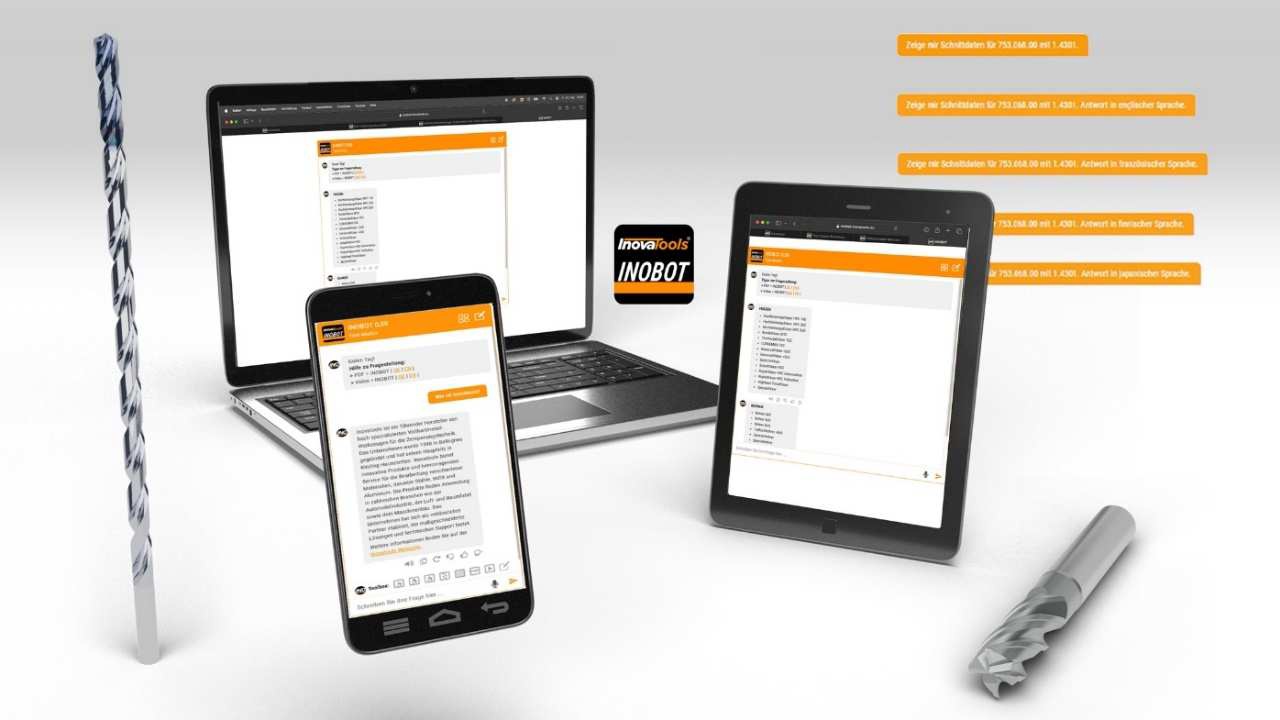
The tool manufacturer Inovatools from Kinding-Haunstetten, Germany, is setting new standards in the industry, and is the first provider to launch its own AI bot for topics related to machining: INOBOT.
The app for iOS and Android provides real-time, in-depth answers to questions about milling, drilling, reaming, threading, and the entire Inovatools product world - at any time and from any location.
Whether it's technical details, application tips or company information: INOBOT is always available, always as precise as possible, and always multilingual. Inovatools is thus also targeting the digitally savvy, younger generation of users and once again underlining its reputation as an innovative pioneer and trendsetter in the machining industry.
Need a practical example? A cutting machine operator is standing at the machine and has a spontaneous question about the optimum cutting value for a high-performance milling cutter from Inovatools. Instead of searching for a long time in the catalog, he simply opens the INOBOT app, enters his question, and receives the right answer within seconds. Fast. Reliable. Efficient.
Marcus Schubert, Head of Sales and Marketing at Inovatools: "The smart opportunity to immerse yourself in the world of Inovatools precision tools has been very well received. The app's high download figures speak for themselves - our customers and all users appreciate receiving reliable answers immediately, whether at work, in the workshop, or in transit.
INOBOT makes our expertise accessible to everyone, around the clock and the world. Simply download INOBOT, get started, and if required, the accompanying PDF and video tutorial will help you get the best possible introduction to the world of INOBOT."
Contact Details
Related Glossary Terms
- gang cutting ( milling)
gang cutting ( milling)
Machining with several cutters mounted on a single arbor, generally for simultaneous cutting.
- milling
milling
Machining operation in which metal or other material is removed by applying power to a rotating cutter. In vertical milling, the cutting tool is mounted vertically on the spindle. In horizontal milling, the cutting tool is mounted horizontally, either directly on the spindle or on an arbor. Horizontal milling is further broken down into conventional milling, where the cutter rotates opposite the direction of feed, or “up” into the workpiece; and climb milling, where the cutter rotates in the direction of feed, or “down” into the workpiece. Milling operations include plane or surface milling, endmilling, facemilling, angle milling, form milling and profiling.
- milling cutter
milling cutter
Loosely, any milling tool. Horizontal cutters take the form of plain milling cutters, plain spiral-tooth cutters, helical cutters, side-milling cutters, staggered-tooth side-milling cutters, facemilling cutters, angular cutters, double-angle cutters, convex and concave form-milling cutters, straddle-sprocket cutters, spur-gear cutters, corner-rounding cutters and slitting saws. Vertical cutters use shank-mounted cutting tools, including endmills, T-slot cutters, Woodruff keyseat cutters and dovetail cutters; these may also be used on horizontal mills. See milling.
- threading
threading
Process of both external (e.g., thread milling) and internal (e.g., tapping, thread milling) cutting, turning and rolling of threads into particular material. Standardized specifications are available to determine the desired results of the threading process. Numerous thread-series designations are written for specific applications. Threading often is performed on a lathe. Specifications such as thread height are critical in determining the strength of the threads. The material used is taken into consideration in determining the expected results of any particular application for that threaded piece. In external threading, a calculated depth is required as well as a particular angle to the cut. To perform internal threading, the exact diameter to bore the hole is critical before threading. The threads are distinguished from one another by the amount of tolerance and/or allowance that is specified. See turning.
